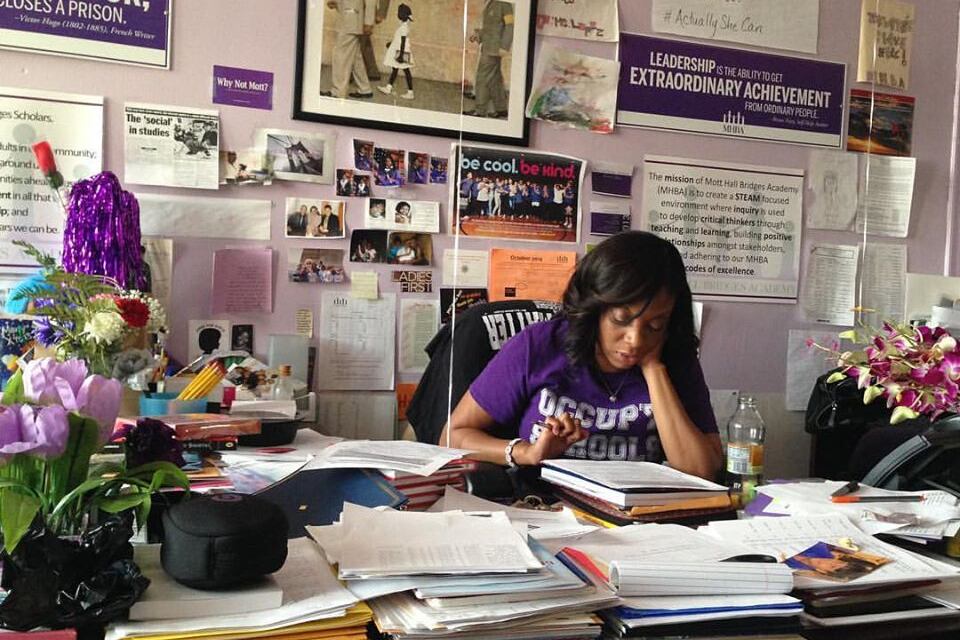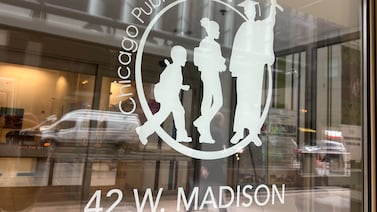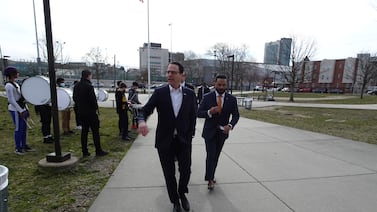All the days of running on iced coffee and precious few hours of sleep had caught up with Principal Nadia Lopez.
About a decade after she founded Mott Hall Bridges Academy in Brownsville, Brooklyn, doctors told Lopez, 43, that stress had triggered an autoimmune disease. Her health problems flared up this spring, while she wrestled with running a school in the epicenter of the coronavirus pandemic. Her doctors gave her a bleak ultimatum: Decide between your health or your job.
Lopez — who became a sensation after one of her students was featured in the popular photo series Humans of New York, landing her an appearance on “Ellen” and a trip to the White House — chose her health. She resigned on July 1.
“I love being a principal. I love my kids. I love my team. But I have decided I need to live, and not die, for this work,” she said.
Even before COVID-19 landed on New York City’s doorstep, the principals union warned that a contract quirk could make the time ripe, financially, for more school leaders than usual to retire. Now the pandemic could hasten their leave, as principals face their own health fears along with heaps of new responsibilities to keep their staff and students safe.
“Though the job of an NYC principal is immensely rewarding, it is also incredibly challenging, taxing and stressful. The work of school leaders has obviously become even more demanding due to the COVID-19 pandemic,” Mark Cannizzaro, president of the Council of School Supervisors and Administrators, the union representing principals and assistant principals, said in a statement. “Though we don’t yet know how many principals will leave the system this year, our concerns about turnover have only grown.”
On Wednesday, the city education department opened applications for teachers and school leaders who prefer to work remotely in the fall because they are at higher risk for serious complications from the coronavirus. Officials have estimated that 20% of educators will choose not to return to school buildings. The estimate has not been broken down for principals, specifically, but a significant number of them may opt to stay home.
School leaders tend to be older than classroom teachers, increasing their chances of becoming seriously ill. The median age for a principal last year was 48, about eight years older than that of teachers, according to the Independent Budget Office. Almost 400 school leaders — almost a quarter of the city’s public school principals — were 55 or older.
As of the end of June, 79 education department employees have died from suspected COVID-19 cases. They include two administrators. Among them was Dez-Ann Romain, a deeply committed principal at a Brooklyn alternative school for students who struggled in traditional settings. The first known education department employee to die from the virus, Romain was only 36.
Others have fallen gravely ill. Larry Lord retired this summer after 22 years as principal of P.S. 235 in Brooklyn. Known as “Superman” within his school community, Lord contracted the virus and spent 80 days in the hospital, during which he was intubated and left so weak he could not speak or read.
The potential risks are layered on top of enormous new pressures since school buildings shut down in mid-March, leaving principals to steer their teachers, students, and parents through the health crisis.
At Mott Hall Bridges, the pandemic only deepened inequities faced by its students, virtually all of whom are Black and Latino. The Brownsville neighborhood where the school is located has been scarred by gun violence, and the median household income is about half that of the rest of the city. People of color and those living in poverty have suffered from the virus at higher rates.
After school buildings closed, Lopez jumped into creating a new virtual model, with night classes for students who shared computers with family members during the day and access to remote mental health counseling for teachers. She also made sure more than 200 backpacks were stuffed with books and sent to students who weren’t able to get online. It felt like starting a school from scratch, just like when she first got Mott Hall Bridges off the ground.
The school year ended in June and all attention turned to preparing for the next school year. September could be even more challenging.
Budgets have been bled. Now principals are tasked with analyzing their building footprints and enrollment to figure out the safest way to have students and staff back on campus next year, all the while educating a portion of their students remotely.
For Lopez, anxiety bubbled as she faced the enormity of decisions ahead of the start of classes. How would she hire the best teachers to fill open spots when interviews would have to happen over Zoom? How could she safely get her team back in the building to prepare for all the needs children will bring with them after months of isolation? How could her budget possibly stretch to pay for the enhanced safety measures needed to reopen?
“It just became very clear and apparent that, ultimately, all the decisions were going to have to be on the principals,” Lopez said. “You’re looking at principals who, at this very moment, are trying to catch a breath. They are overwhelmed.”
Well before the outbreak started, the principal’s union began sounding the alarm that school leaders faced a potential financial incentive to retire. After years without a contract under the previous mayoral administration, the union in 2014 won a series of retroactive raises that topped out in 2018.
With pensions calculated on the last three years of a principal’s salary, the pay boost could encourage more people than usual to head for the exits within the next 18 months, union officials have said. Last year, city figures show that almost 160 principals had reached retirement age and 30 years of service, which qualifies them to begin drawing a pension without any penalties.
The Independent Budget Office estimates that some 400 candidates are in various training programs to become principals, but it’s unclear how quickly those educators could be put in charge of schools. Danielle Filson, a spokesperson for the education department, declined to detail the city’s plans to fill open principal positions.
“Throughout this crisis, we are supporting our schools every step of the way including through any potential leadership changes. The majority of eligible principals do not typically retire, but we remain ready to fill any vacancies that arise,” Filson said.
The question now is how many want to take on the job. Lopez said the stress and health concerns tied to the coronavirus finally pushed her out, but her frustration started well before the pandemic.
Faced with the challenges of a hyper-segregated school, Lopez and her teachers were forced to contend with deep social, racial, and economic injustices that can make learning harder. Though Mott Hall Bridges pushes students to make academic gains once they enroll, children enter the school significantly behind on state tests measuring proficiency in math and English — and struggle to catch up with their peers across the city.
Lopez said evaluations of the school and her own leadership would often note areas to work on, but offered little guidance for how to actually get better. Without more support to improve, “You start to feel defeated,” she said.
“Everything we’re expected to do for our teachers and our students isn’t translated into, ‘How do we support our principals?’” she said. “Now in the middle of a pandemic, it’s like, ‘Ya’ll got to figure it out.’”
Lopez added: “I wasn’t trying to be a martyr.”







